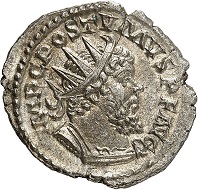It is the cuirassed bust devoid of any drapery featured on the obverse of this antoninianus that makes this piece so unique and distinguishes it from the tens of thousands of others we know from coin hoards, public and private collections, as well as auction catalogs. During the reign of Postumus, antoniniani generally showed a ruler’s bust that was cuirassed AND draped, and this also applies to those pieces whose reverse inscription reads IOVI STATORI.
Postumus, 260-269. Antoninianus, Cologne, January 268. IMP C POSTVMVS PF AVG bust only(!) with armor and radiate crown r., drapery on l. shoulder. Rv. IOVI – S-TATORI Jupiter with long sceptre and thunderbolt in the left arm, standing slightly l., head turned r. C. -. AGK -. Elmer -. Cunetio -. BSFN 72/02 (2017), p. 56ff, fig. 1. 3,44 g. 12 h. Unique, of the best style possible, in an extremely fine grade. Estimate: 2,500 euros. From Jacquier sale 43 (September 15, 2017), No. 290.
The only comparisons we have date from the beginning of 268, for instance an antoninianus that combines on its reverse Iupiter Stator with a heroic bust of the emperor to the left: As attributes of Hercules, the emperor carries the club and wears the lions’ skin, supplemented by a sword belt. In the same period the Milan mint was commissioned by Aureolus to strike antoniniani that featured two special busts that were then combined with the usual kinds of reverse. The first is a bust that is only cuirassed while the second is a naked bust with a small aegis.
This provides the background to the surprising new antoninianus. It is definitely neither a mistake of the engraver nor the quality product of an ancient counterfeiter. The characteristic style of the inscriptions, the superbly carved portrait, and the quality of the metal give rise to the assumption that this surprising striking is a surviving example of a marginal official antoninianus coinage featuring a cuirassed bust.
Postumus, 260-269. Antoninianus , Cologne, 1st half of 268. Rv. P M TR P VIIII COS IIII P P bow, club and round(!) quiver. AGK -. Elmer -. Cunetio 2448. Very rare. Very fine. Estimate: 250 euros. From Jacquier sale 43 (September 15, 2017), No. 293.
This extremely rare portrait without a military commander’s cloak can be dated to the beginning of 268. In terms of chronology, it runs alongside the coinage that features the emperor Hercules-like, with club and lion’s skin. This edition also includes
- billon aurei and denarii celebrating Postumus’ fourth consulship (P M T P COS – IIII P P),
- antoniniani that identify the emperor with Hercules (P M TR P VIIII COS IIII P P and HERCVLI ROMANO AVG bow, club and quiver)
- as well as antoniniani for the Pax Augusta (PAX AVG)
- and for Jupiter Stator (IOVI STATORI).
Jupiter’s epithet Stator recalls an episode from the early history of Rome, which is recorded in Livy I. 12. 4-7: After the founding of the city, the Romans engaged in a war with the Sabines who then brought them close to defeat. In this situation, Romulus swore an oath to build a sanctuary for Jupiter, in return for his help. Romulus then asked the already fleeing Romans to stand still (stare = Lat. for ‘to stand’) in order to resume the fight. It worked. The Romans drove the enemy back. And, as Jupiter Stator, Jupiter got his sanctuary in the very heart of Rome.
This mythical victory becomes the model for many further victories of the Roman army, for which Jupiter Stator is paid homage. It is the same with the present case. Postumus celebrates retrospectively the good result of his 266 and 267 campaigns against Gallienus. Like the great hero Hercules, the emperor places himself at the head of his troops, to force the intruder to retreat and to restore peace in his Gallic Empire. This fact alone suffices to illustrate the importance of Postumus as a military commander, and so the coin imagery can easily do without the customary military commander’s cloak.
However, the question remains whether this extraordinary bust only exists with the IOVI STATORI reverse inscription or whether it has been combined with other types of reverses as well. Probable though the latter seems it is left to other, hitherto unknown coin types to serve as ultimate proof.
After Dominique Hollard, BSFN 2/2017, p. 56-59.
Please find Jacquier sale 43 on Sixbid.
And the relevant CoinsWeekly auction preview can be read here.









